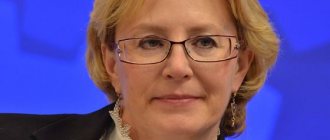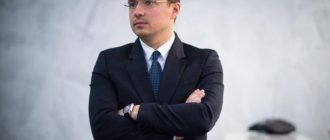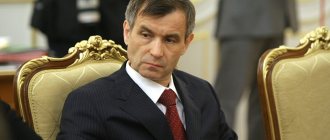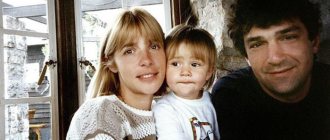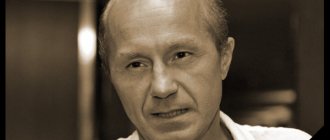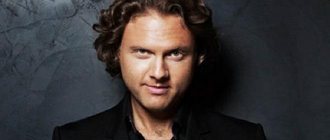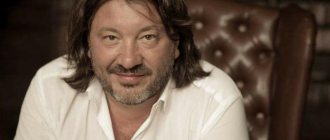Birth and family
Nursultan was born in the village of Chemolgan, Alma-Ata region, Kazakh SSR on July 6, 1940. To be even more precise, my mother gave birth to her long-awaited first child in the high-mountainous jailau Ushkonyr in the Trans-Ili Alatau (this is a summer pasture for livestock). In total, four children were born in the family; Nursultan also has two younger brothers and a sister.
His father, Abish Nazarbayev, born in 1903, was born into the family of shepherd Nazarbay and lived at the mountain foot of Alatau. He spoke excellent Kazakh, Balkar and Russian languages. He was a cheerful person, he sang Russian folk and Kazakh songs with soul. He was greatly respected because he could always listen to his interlocutor and give him useful advice. He worked on the construction of the Turksib railway, which connected Siberia and Central Asia, where he met his future wife.
Nazarbayev with his parents, brothers and sister
Nursultan's mother's name was Alzhan. She was born in the village of Kasyk, Dzhambul region in 1910, the daughter of a rural mullah. Under Soviet rule, such a spiritual title cost Alzhan’s father and his entire family deportation from their homeland. The girl ended up at the construction site of the Turkestan-Siberian Railway, where she met foreman Abish. Everyone who knew her noted her cheerful and cheerful character; Alzhan sang and improvised wonderfully.
Both Nursultan’s mother and father were great workers. Alzhan, in addition to running a household and raising four children, worked on a collective farm. Without straightening her back, she grew beets under the scorching sun.
From the age of five I went to grooms
The first bride for Nursultan Nazarbayev was chosen by his parents. This event happened when he was barely five years old, and the bride had just been born.
“In the fall of 1945, he and his father Abish were visiting a friend’s family, his neighbors in Chemolgan,” wrote English biographer Jonathan Aitken . — They celebrated the birthday of their daughter, whom they named Astai . The name day ceremony turned into an engagement party as both parents formally agreed that their children should get married. Despite the fact that Astai was still in the cradle, and Nursultan was just a child. Engagement, in accordance with Kazakh traditions, has become an obligation.”
In the family of Nursultan Nazarbayev, their son’s future marriage was taken very seriously. Alzhan, the mother of the future president, often invited young Astai to visit and every time she said: “One day our house will be yours.” But the prospect of marrying a neighbor did not suit young Nursultan. “Even in the first grade, my classmates teased me, shouting after me: “There goes the groom,” Nazarbayev told the English writer. “It embarrassed me a lot.” The teasing continued and I began to avoid my neighbor. When I saw her, I ran away."
When Nursultan and Astai grew up, they had a serious conversation. The neighbor demanded to tell her frankly when he intended to marry her. Or let her refuse the wedding, which will officially release her from the promise made by her father. “I release you, you can marry another person. I said these words with great relief,” Nursultan Nazarbayev recalled years later.
This was a very serious and responsible decision for a young man from a traditional Kazakh family.
Childhood
When Nursultan was born, there was a whole story about choosing a name for the boy. Relatives gathered and began vying with each other to suggest different names. The decision was made by grandmother Myrzabal, who could not get enough of her first grandson: “Let the boy have two names at once - Nur and Sultan.” This is how the name Nursultan was formed. “Nur” is translated from Arabic as “ray, light, radiance, purity.” And “Sultan” means “best, ruler, chosen, lord, noble, ruler.”
Nursultan in his youth with friends
Nursultan's childhood fell on difficult war and post-war times. My father was not taken to the front because of his disability; even before the war, during a fire, his arm was severely burned, after which it stopped bending and began to dry out. Despite the hunger, the boy remembered his childhood as the best time with his father’s caring attention, his mother’s affectionate hands, a friendly family, sincere parental songs, exciting children’s games and the most beautiful Alatau valleys.
Dad never sat idle, and his son helped him with everything from an early age - with household chores, in the apple orchard, in the vegetable garden. Together they went to the mountains to cut hay, looked after livestock, and grew potatoes and apples.
Nursultan Nazarbayev: biography
Nursultan Nazarbayev is the first president of the Republic of Kazakhstan, to whom the people entrusted the leadership of the country for the sixth time. He is considered the world record holder for the longest stay in power and successfully ruled Kazakhstan for almost 30 years, until March 19, 2019.
In 2007, for his services to his homeland and achievements in his position, the parliament of Kazakhstan approved Nazarbayev’s right to hold the position of president for life. However, the politician himself made a different decision.
President Nursultan Nazarbayev
Nursultan Abishevich Nazarbayev was born on July 6, 1940 in the Alma-Ata region in the village of Chemolgan. His parents were ordinary agricultural workers, but highly respected people in the village. They raised their children with love and care, instilling in them national traditions, reverence and respect for adults. The childhood of the future Kazakh president fell on the difficult war and post-war years, when the consequences of the grueling Cold War fell heavily on the shoulders of the common people. But the care and love of their parents helped Nursultan Abishevich, his sister and brothers survive the hunger and grief of those years, which allowed them to grow up as cheerful, hard-working and sensitive people for whom friendship and mutual assistance were the meaning of life.
Nursultan Nazarbayev with his family
The school years of the only president of Kazakhstan were bright and eventful at the Kaskelen school. He was an inquisitive and diligent student, whom teachers singled out from all students at school. Nursulstan Nazarbayev was especially fond of reading books and sports. It should also be noted that from his earliest years, the future Kazakh leader strove for leadership, was a social “ringleader” and knew how to win people over from the first minute of communication.
Nursultan Nazarbayev with his mother
Immediately after graduating from high school, Nursultan Abishevich, wanting to get on his feet as quickly as possible and help his parents financially, decided to become a metallurgist and went to Temirtau, where a large construction of a metallurgical plant began. As a young specialist, he was sent to study at a vocational school in Ukraine in the city of Dneprodzerzhinsk. However, metallurgy was not the only industry in which a strong and purposeful guy showed himself. He actively showed himself in sports, proving his skills on the wrestling grounds.
Nursultan Nazarbayev in his youth
In 1960, the future head of the Republic of Kazakhstan successfully graduated from vocational school and received a diploma in metallurgy. During that period, Nursultan Nazarbayev’s work biography began - he became a participant in the first smelting of Kazakh iron and plunged headlong into work. The 20-year-old guy honestly divided his salary as a metallurgist, which was small, in half and sent half to his father, who spent the money on raising Nursultan Abishevich’s younger brothers and sister.
Very soon the young metallurgist showed his professionalism in metallurgy and, with several of his comrades, was sent to the Karaganda Polytechnic Institute at the metallurgical faculty. After studying for three years at this institution, the young specialist was redirected to the VTUZ Plant, from which he successfully graduated and received a diploma as a metallurgical engineer.
School years
Many of the guys among Nursultan’s friends were from among the evacuees, but they never divided their games by nationality. The division of boyish gangs took place along the streets where they lived. Sometimes they fought street to street, but in especially difficult periods the fights faded into the background, and the main thing was mutual assistance and friendship.
Nursultan with classmates at the last school bell
The magical world of knowledge began to interest little Nazarbayev early on. At school he was a diligent student, one of the best in his class. He especially loved to read; as soon as he managed to get another book somewhere, he plunged headlong into it. And in the summer, when they grazed cattle in the foothills of Alatau and spent the night by the fire, Nursultan liked to listen to the stories of his elders about previous generations of Kazakhs.
At the presentation of certificates of secondary education, the head teacher of the school noted Nazarbayev’s analytical mind and curiosity. His excellent knowledge and broad outlook markedly distinguished him from his classmates. During my school years I always played sports, was physically strong and looked older than my peers. But the most important qualities that appeared in him already at that time were the desire for leadership and the ability to competently build relationships. In companies he was always the leader, he sang, joked, and quickly won people over.
Carier start
Nazarbayev’s work biography began in the Domenstroy construction department, where he worked for nine years, from 1960 to 1969. At the same time, Nursultan Abishevich managed to combine work with education. His determination did not go unnoticed, and in 1969 Nazarbayev was made head of the transport and industrial department in the Temirtau city committee. In addition, the future president was transferred to a vacant Komsomol job. The leadership knew how old Nazarbayev was, but, despite Nursultan’s young age, they appointed him to the position of secretary of the Komsomol committee. Later he joined the deputies of the regional council and became a member of the city party committee.
From 1973 to 1984, Nursultan served as secretary. Only the organizations in which he worked changed. Nazarbayev worked in the regional party committee, and in the party committee of the metallurgical plant, and even in the Central Committee of the Communist Party.
Labor path
Being the eldest son in the family, Nursultan wanted to quickly get on his feet and help his parents. Therefore, having learned that recruitment was underway for a large Komsomol construction site of a metallurgical plant in Temirtau, he went there. The guy believed that large-scale construction would open up a great life and broad prospects for him. From Temirtau he was sent to Ukraine to study at a vocational school at the Dnieper Metallurgical Plant.
In 1960, he graduated from a vocational school with a specialty in blast furnace workers and became a master of sports of the Ukrainian SSR in wrestling. Nazarbayev returned to Temirtau, where his working life began.
Already in the summer of 1960, he smelted the first Kazakh cast iron at the Karaganda Metallurgical Plant. Here he worked his way up from a cast-iron operator of casting machines to a blast furnace forge operator. The terrible heat and hard work did not frighten him. A physically strong guy, he steadfastly overcame all difficulties. Nursultan also had time for Komsomol activities; as a leader in production, he was often sent from the plant to festivals and congresses of the Komsomol.
In 1967, Nazarbayev received a diploma from the Karaganda Polytechnic Institute with a degree in foundry production of ferrous and non-ferrous metals. In 1969, he accepted the offer to switch to party work.
Nazarbayev's political career began in 1973. At his native metallurgical plant, he took the position of secretary of the party committee.
In 1979, his merits and authority allowed Nursultan to take the post of Secretary of the Central Committee of the Communist Party of the Kazakh SSR. In 1984, he headed the Council of Ministers of the Republic. Since 1990, Nazarbayev became a member of the CPSU Central Committee.
Activities of a party functionary
The biography of the President of Kazakhstan Nursultan Nazarbayev includes long-term work in party positions. In 1969, he left the plant and began party activities, initially organizing various festivals and public events in the city of Temirtau. In 1973, at his native Karaganda Metallurgical Plant, he received the position of chief secretary of the party committee. This is a very significant post, which in those days was equivalent to a director’s position. During these years Nazarbayev:
- was involved in planning the work of the plant;
- worked on organizational issues;
- solved personal problems of workers.
Nursultan Abishevich is actively involved in party activities, thanks to his efforts, working conditions have significantly improved both at the metallurgical plant and at other enterprises.
He knew firsthand about all the difficulties at his native plant and could put his knowledge into practice, increasing labor efficiency and making the lives of workers easier. At the same time, the politician actively studied, studied news and various books that the Academy of Sciences published, and personally wrote interesting works on the history of the origin of the Kazakh nation.
In 1979, Nursultan Nazarbayev was appointed secretary of the Central Committee of the Communist Party of the Kazakhstan SSR, and five years later he headed the Council of Ministers of the republic. Such rapid career growth is explained by his authority among the population and numerous merits while working at the metallurgical plant. Since 1990, Nazarbayev has been a member of the Central Committee of the CPSU, but at the same time he perfectly understood that the days of the Soviet Union were numbered, so he would soon have to raise his already independent native Kazakhstan from the ruins.
President of Kazakhstan
After the collapse of the USSR, Nazarbayev became the first President of Kazakhstan. During this period, he ushered in a new era for his independent country. The most powerful indicators in the economy were achieved. He wisely avoided all the sharp corners, sometimes made cold-blooded political decisions, thanks to which Kazakhstan turned into a successful and powerful state, becoming one of the fifty most developed countries in the world.
Nursultan Abishevich always tried to work for the benefit of people. If necessary, he was in the heat with metallurgists and in the adits with miners. He always made reasonable decisions and avoided conflicts on ethnic grounds without bloodshed, which earned him unquestioned authority among the people of the country.
In foreign policy, Kazakhstan has taken a “nuclear-free track”. In Semipalatinsk, warheads remaining from Soviet times were destroyed.
In 1995, during a referendum, his powers were extended until 2000. With a huge number of electoral votes, Nazarbayev won the presidential elections in 1999 and 2005.
In 2007, changes to the constitution were adopted, according to which Nazarbayev has the lifelong right to be President of Kazakhstan.
In 2007, he initiated the creation of the Eurasian Economic Union. As a result of the signing of the agreement, Russia, Belarus, Armenia and Kyrgyzstan became the most important economic partners of Kazakhstan. Today, many countries express a desire to cooperate with the EAEU.
At the beginning of its independence, the Republic exported practically nothing. Today, Kazakhstan supplies 2,500 types of products to 119 countries. Unemployment was reduced at a tremendous pace. Since 2003, pensions and salaries have increased more than tenfold.
Nazarbayev Nursultan Abishevich
Quotes
I believe that the need to create a world energy organization is ripe. June 18, 2011
I propose to begin positioning the city of Almaty as the financial center of the Eurasian Economic Union. May 29, 2014
Gasification of central and northern Kazakhstan must be carried out within 1-1.5 years. March 5, 2020
Decided to terminate his powers as president. March 19, 2020.
The world is moving towards a new monetary and financial system: from defectalism to acmetallism. May 3, 2011
When the volume of produced gas reaches 60-80 billion m3/year, Kazakhstan will become a major gas exporting country. December 6, 2020
For Kazakhstan, Russia has always remained the first partner, especially in such difficult matters as transporting gas and oil to Europe. March 26, 2007
Kazakhstan has a special relationship with Chevron. November 21, 2020
Hide quotes Show all
Biography
Nursultan Abishevich Nazarbayev was born on July 6, 1940 in the village of Chemolgan, Kaskelensky district, Alma-Ata region.
In 1967 he graduated from the VTUZ plant at the Karaganda Metallurgical Plant.
In 1976 - correspondence Higher Party School under the CPSU Central Committee.
Doctor of Economic Sciences.
1960 - 1969 he worked at the Karaganda Metallurgical Plant.
1969-1973 - at party and Komsomol work in the city of Temirtau, Karaganda region.
1973-1977 - Secretary of the Party Committee of the Karaganda Metallurgical Plant.
1977-1979 - secretary, second secretary of the Karaganda regional party committee.
1979-1984 - Secretary of the Central Committee of the Communist Party of Kazakhstan.
1984-1989 - Chairman of the Council of Ministers of the Kazakh SSR.
1989-1991 - First Secretary of the Central Committee of the Communist Party of Kazakhstan. At the same time, from February to April 1990 - Chairman of the Supreme Council of the Kazakh SSR.
Since April 1990 - President of the Republic of Kazakhstan.
On December 1, 1991, the first popular elections of the President of the Republic took place, during which N. Nazarbayev received the support of 98.7% of voters.
On April 29, 1995, as a result of a national referendum, the powers of President N. Nazarbayev were extended until 2000.
On January 10, 1999, during early elections, he was again elected President of the Republic of Kazakhstan, receiving 79.78% of the votes.
On December 4, 2005, he was once again elected President of the Republic of Kazakhstan, receiving 91.15% of the votes.
At the beginning of 2011, the Constitutional Council of Kazakhstan recognized the law adopted by the parliament as inconsistent with the Constitution, which provided for a referendum on extending the powers of the current president until 2020 instead of elections in 2012.
Following this, the Kazakh parliament adopted amendments to the Constitution of the republic, which gave Nazarbayev the right to announce early presidential elections, which he immediately announced.
The elections took place on April 3, 2011. Nazarbayev won with a result of more than 95%.
In the elections in April 2020, N. Nazarbayev also received more than 95% of the votes
N. Nazarbayev holds the post of Chairman of the Assembly of the People of Kazakhstan, and also heads the World Association of Kazakhs.
In 1997, N. Nazarbayev moved the capital from the south of the country from Alma-Ata to the north - to Akmola, later renamed Astana (to prevent the possible loss of the northern territories of Kazakhstan, populated predominantly by Russians).
At the same time, he introduced people related to him by blood into the highest echelons of power in the country.
N. Nazarbayev relied on a nuclear-free foreign policy of Kazakhstan, closing the nuclear test site in Semipalatinsk and destroying all nuclear warheads remaining in the republic from Soviet times.
During 1996-2005, Kazakhstan completely completed the delimitation of borders with neighboring states.
Under N. Nazarbayev, Kazakhstan joined a number of military-political blocs, political and economic organizations - the CST (1992; since 2002 - the CSTO), the OSCE (1992), the Central Economic Cooperation Organization (1994), the Shanghai Five (1995, transformed into 2001 in the SCO), EurAsEC (2000), CICA (2002), CES (2003). The President announced Kazakhstan's intention to join the WTO. At the same time, according to experts, Kazakhstan was never able to become an undisputed leader in the Central Asian region, and its main political and economic partners were Russia, China and the United States. Based on the fact that Kazakhstan does not have access to the sea, N. Nazarbayev relied on the maximum use of the country’s land transport and communication potential. Based on the presence in the republic of a relatively developed infrastructure for transporting oil and gas from producing regions to Russian pipeline systems, N. Nazarbayev in October 2005 announced Kazakhstan’s intention in the next ten years to enter the top ten largest suppliers of oil to the international market, as well as In 2006, he signed an agreement with Azerbaijan on the joint use of the Baku-Tbilisi-Ceyhan oil pipeline, the route of which bypasses Russian territory.
N. Nazarbayev became one of the participants in the corruption case in Kazakhstan, also known as Kazakhgate.
At the end of 1999, Swiss investigators discovered and froze several bank accounts allegedly belonging to high-ranking Kazakh officials, including N. Nazarbayev himself.
It turned out that the money in these accounts came mainly from American oil companies.
In 2000, the United States joined the investigation, and in July 2000, several more accounts were discovered and frozen, also allegedly belonging to the President of Kazakhstan.
Their total amount was about $1 billion.
The Kazakh authorities have repeatedly tried to hush up the scandal, and in May 2004, N. Nazarbayev for the first time expressed his attitude to this matter, publicly renouncing Kazakhgate.
However, in 2007, the Kazakh authorities abandoned their claims to these funds and the US Department of Justice signed a decision to confiscate $84 million from a Swiss bank account belonging to the Treasury of the Ministry of Finance of Kazakhstan in favor of the children's fund.
On March 19, 2020, N. Nazarbayev announced his resignation.
The duties of the President of Kazakhstan before the official elections of the head of state were performed by the Speaker of the Senate of the Parliament Kassym-Jomart Tokayev, who was later elected by the President
N. Nazarbayev was awarded the Order of the Red Banner of Labor and the Order of the Badge of Honor.
The ex-president's wife, Sarah, heads the Bobek International Children's Charitable Foundation.
The ex-resident has 3 daughters:
- Dariga - since March 20, 2020, has been the Speaker of the Senate of Kazakhstan;
- Dinara heads the N. Nazarbayev Educational Foundation;
- Aliya is engaged in business.
Personal life
In 1961, at the Karaganda Metallurgical Plant, Nursultan had a fateful meeting with the girl Sarah, who worked at an electrical substation and came to see the accident that occurred with the blast furnace. She immediately drew attention to the young man, despite the fact that he was collapsing from fatigue and covered in soot, because they had been clearing out the emergency for almost 24 hours.
Already in 1962, their youth-Komsomol wedding died down. And then the children came - three daughters. Dariga was born in 1963, Dinara in 1967, Aliya in 1980.
The wife and all of Nazarbayev’s daughters are engaged in social and political activities. Sara Alpysovna organized the International Children's Charitable Foundation “Bobek” (“Baby”), which provides support to orphans, disabled people and single mothers. Daughter Dariga is a member of the Senate of Parliament, Doctor of Political Sciences. Dinara heads the Education Fund and the People's Bank of Kazakhstan. Aliya is engaged in production activities in the film industry and heads the construction industry.
Nazarbayev has eight grandchildren and five great-grandchildren.
Personal life of Nursultan Nazarbayev
The official wife of the President of Kazakhstan is Sara Alpysovna Nazarbayeva, whom he married in 1962, while still a simple worker. Sarah gave birth to the future leader of the nation three daughters: the eldest Dariga (born in 1963), Dinara (born in 1967) and Aliya (born in 1980).
Nursultan Nazarbayev and his wife Sara
All daughters of Nursultan Nazarbayev take part in the social and political life of Kazakhstan.
Dariga is a Doctor of Political Science, senator of the republic’s parliament, and head of the Khabar media holding. It is widely believed that Dariga is not the president’s own daughter, who was born in Sara Alpysovna’s first marriage. Until 2007, she was married to media tycoon Rakhat Aliyev. The divorce followed a criminal case opened against the president’s son-in-law - Aliyev was accused of kidnapping the vice-chairman of the leading bank of the republic, Nurbank, Zholdas Timraliev.
Nursultan Nazarbayev with his daughters and grandchildren
Dinara is the richest woman in the country according to Forbes, and heads a number of charitable foundations of national importance. Married to the head of the National Chamber of Entrepreneurs of Kazakhstan, Timur Kulibayev.
Aliya is a businesswoman, an ardent environmentalist, and a philanthropist. Its projects include cellular communication lines “Dalacom” and “Pathworld”, a network of fitness clubs “Luxor”, and construction. At the age of 18, she married the son of then President Askar Aliyev, Aidar Akayev. In 2001, the marriage broke up; the girl immediately formalized her relationship with football player and subsequently entrepreneur Daniyar Khasenov.
The wealth of Nazarbayev and his family The daughters gave the President of Kazakhstan eight grandchildren. By his 76th birthday, Nursultan Abishevich became a great-grandfather 15 times.
